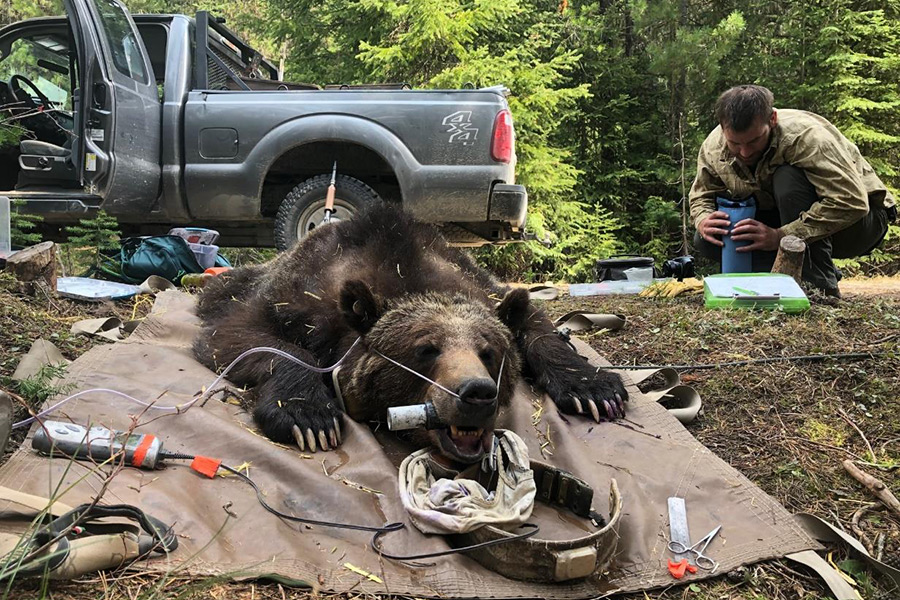A groundbreaking grizzly bear augmentation program in the Cabinet-Yaak recovery area is producing degrees of success as researchers document new offspring from the transplanted bears.
According to Wayne Kasworm, the U.S. Fish and Wildlife Service grizzly manager in Libby, seven new augmentation offspring were identified in the Cabinet Mountains of Northwest Montana from genetic samples collected in 2017. The genetic results also indicate that a male grizzly bear released in the Cabinets in 2011 as a 2-year-old bruin has reproduced.
“This is the first instance of new male genes in the population because of the augmentation effort,” Kasworm said.
Kasworm announced the genetic results as part of his spring update on grizzly bear monitoring in the Cabinet-Yaak and Selkirk recovery areas.
The augmentation program continues to be a success in an ecosystem that saw its grizzly bear population nearly vanish 30 years ago. In 1988, biologists estimated fewer than 15 grizzly bears remained in the Cabinet-Yaak, which spans approximately 1,000 square miles in the Yaak River drainage and 1,620 square miles in the Cabinet Mountains.
The augmentation program involves transplanting bears from other recovery areas into habitat that is part of the Cabinet-Yaak.
The Cabinet-Yaak and Selkirk recovery areas each hold about 55 grizzly bears in the remote mountains along the Canadian border with Montana, Idaho and Washington. They’re dwarfed by the Northern Continental Divide Ecosystem, which has an estimated 1,000 grizzlies in the mountains between Glacier National Park and Missoula.
Today, thanks largely to an augmentation program that Kasworm helped establish, there are an estimated 55-60 grizzly bears in the Cabinet-Yaak Ecosystem, with a projected growth rate of 2.1 percent annually.
Grizzly bears are protected as a threatened species under the federal Endangered Species Act and cannot be hunted in the Lower 48 states.
About 750 grizzlies are in the Greater Yellowstone Ecosystem and surrounding Yellowstone National Park. That population was delisted from the Endangered Species Act in 2017, but a federal judge in Missoula reversed the delisting last September. Federal officials have moved forward with an appeal of the judge’s decision.
Kasworm’s team began 2019 with six collared grizzly bears in the Cabinet-Yaak (two females and four males). One of the females was spotted in May with two new cubs.
“The other female is 4 years old and probably too young to reproduce,” Kasworm said.
In one instance, a 2-year-old male that was captured near Rathdrum, Idaho and relocated to the west Cabinet Mountains in August 2018 traveled to north of Bonner’s Ferry, Idaho and eventually into the Yaak River drainage. The bear denned near the international border, Kasworm said. In 2019, the bear emerged and traveled into British Columbia and then west to Creston, B.C. In late May, the bear moved south of the border and killed several sheep east of Porthill, Idaho and three days later killed two more sheep about five miles south of the first depredation.
Traps were set and the bear was captured. Idaho Fish and Game and the U.S. Fish and Wildlife Service made a joint decision to euthanize the bear.
The destruction of the bear is considered a human-caused mortality, and marks the only human-caused mortality in the Cabinet-Yaak this year.
Under Kasworm’s guidance, the Cabinet-Yaak augmentation program continues to be a success in an ecosystem that saw its grizzly bear population nearly vanish 30 years ago. In 1988, biologists estimated fewer than 15 grizzly bears remained in the Cabinet-Yaak, which spans approximately 1,000 square miles in the Yaak River drainage and 1,620 square miles in the Cabinet Mountains.
So far, the program has introduced 20 grizzlies into the Cabinet-Yaak Ecosystem.
Illustrating the intent and success of the program, the third bear moved through augmentation, a female in 1993, is responsible for at least 25 descendants through three generations. That female produced at least 10 first-generation offspring, which gave rise to at least 14 additional grizzly bears, and among those at least one offspring and counting.
The recovery goal is 100 grizzly bears in the Cabinet-Yaak, and managers hope over time the animals will link with surrounding yet separate ecosystems: the Selkirk to the west, the Northern Continental Divide to the east, the Bitterroot to the south, and British Columbia to the north.
Part of the problem for bears increasing gene flow between the recovery areas is that the male grizzlies are moving between the main Cabinet Mountains and the Yaak during the fall rather than in spring, when breeding occurs. Another issue preventing reproduction could be the young bears aren’t yet competitive enough to successfully mate.
